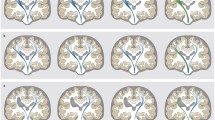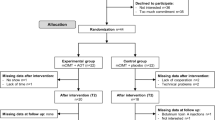Abstract
Individuals with unilateral cerebral palsy (CP) demonstrate reduced performance in upper limb tasks compared to typically developing (TD) peers. We examined whether task conditions modify differences between teenagers with and without CP during a reciprocal aiming task. Twenty teenagers (nine CP and 11 TD) moved a pointer between two targets as fast as possible without missing a target. Task conditions were manipulated by changing the targets’ size, by modifying the inertial properties of the pointer and by varying the upper limb used to perform the task (preferred/non-affected and non-preferred/affected upper limbs). While compared to TD peers, CP teenagers exhibited lower performance (longer movement times). Such differences were attenuated when the task was performed with the preferred upper limb and when accuracy requirements were less stringent. CP teenagers were not differentially affected by the pointer inertia manipulation. Task conditions not only affected performance but also joint kinematics. CP teenagers revealed less movement at the elbow and more movement at the shoulder when performing the task with their less skilled upper limb. However, both CP and TD teenagers demonstrated a larger contribution of trunk movement when facing more challenging task conditions. The overall pattern of results indicated that the joint kinematics employed by individuals with unilateral CP constituted adaptive responses to task requirements. Thus, the explanation of the effects of unilateral CP on upper limb behavior needs to go beyond a context-indifferent manifestation of the brain injury to include the interaction between task demands and action capabilities.







Similar content being viewed by others
References
Barela AMF, Almeida GL (2006) Control of voluntary movements in the non-affected upper limb of spastic hemiplegic cerebral palsy patients. Braz J Phys Ther 10(3):325–332. doi:10.1590/S1413-35552006000300012
Beckung E, Hagberg G (2002) Neuroimpairments, activity limitations, and participation restrictions in children with cerebral palsy. Dev Med Child Neurol 44(5):309–316. doi:10.1111/j.1469-8749.2002.tb00816.x
Bongers RM, Fernandez L, Bootsma RJ (2009) Linear and logarithmic speed-accuracy trade-offs in reciprocal aiming result from task-specific parameterization of an invariant underlying dynamics. J Exp Psychol Hum Percept Perform 35(5):1443–1457. doi:10.1037/a0015783
Bootsma RJ, Fernandez L, Mottet D (2004) Behind Fitts’ law: kinematic patterns in goal-directed movements. Int J Hum Comput Stud 61(6):811–821. doi:10.1016/j.ijhcs.2004.09.004
Braendvik SM, Elvrum AK, Vereijken B, Roeleveld K (2010) Relationship between neuromuscular body functions and upper extremity activity in children with cerebral palsy. Dev Med Child Neurol 52(2):e29–e34. doi:10.1111/j.1469-8749.2009.03490.x
Buchanan JJ, Park JH, Ryu YU, Shea CH (2003) Discrete and cyclical units of action in a mixed target pair aiming task. Exp Brain Res 150(4):473–489. doi:10.1007/s00221-003-1471-z
Butler EE, Ladd AL, Louie SA, Lamont LE, Wong W, Rose J (2010) Three-dimensional kinematics of the upper limb during a reach and grasp cycle for children. Gait Posture 32(1):72–77. doi:10.1016/j.gaitpost.2010.03.011
Cohen J (1988) Statistical power analysis for the behavioral sciences, 2nd edn. Erlbaum, Hillsdale
Domellöf E, Rösblad B, Rönnqvist L (2009) Impairment severity selectively affects the control of proximal and distal components of reaching movements in children with hemiplegic cerebral palsy. Dev Med Child Neurol 51(10):807–816. doi:10.1111/j.1469-8749.2008.03215.x
Duque J, Thonnard JL, Vandermeeren Y, Sébire G, Cosnard G, Olivier E (2003) Correlation between impaired dexterity and corticospinal tract dysgenesis in congenital hemiplegia. Brain 126(Pt 3):732–747. doi:10.1093/brain/awg069
Eliasson AC, Krumlinde-Sundholm L, Rösblad B, Beckung E, Arner M, Öhrvall AM, Rosenbaum P (2006) The manual ability classification system (MACS) for children with cerebral palsy: scale development and evidence of validity and reliability. Dev Med Child Neurol 48(7):549–554. doi:10.1111/j.1469-8749.2006.tb01313.x
Fedrizzi E, Pagliano E, Andreucci E, Oleari G (2003) Hand function in children with hemiplegic cerebral palsy: prospective follow-up and functional outcome in adolescence. Dev Med Child Neurol 45(2):85–91. doi:10.1111/j.1469-8749.2003.tb00910.x
Fernandez L, Bootsma RJ (2004) Effects of biomechanical and task constraints on the organization of movement in precision aiming. Exp Brain Res 159(4):458–466. doi:10.1007/s00221-004-1964-4
Fitts PM (1954) The information capacity of the human motor system in controlling the amplitude of movement. J Exp Psychol 47(6):381–391. doi:10.1037/h0055392
Fonseca ST, Holt KG, Saltzman E, Fetters L (2001) A dynamical model of locomotion in spastic hemiplegic cerebral palsy: influence of walking speed. Clin Biomech 16(9):793–805. doi:10.1016/S0268-0033(01)00067-5
Fonseca ST, Holt KG, Fetters L, Saltzman E (2004) Dynamic resources used in ambulation by children with spastic hemiplegic cerebral palsy: relationship to kinematics, energetics, and asymmetries. Phys Ther 84(4):344–354
Freedman D, Pisani R, Purves R (eds) (2007) The root-mean-square. §4.4. In: Statistics, 4th edn. W. W. Norton & Company, New York, pp 66–67
Gribble PL, Mullin LI, Cothros N, Mattar A (2003) Role of cocontraction in arm movement accuracy. J Neurophysiol 89(5):2396–2405. doi:10.1152/jn.01020.2002
Guiard Y (1993) On Fitts’s and Hooke’s laws: simple harmonic movement in upper-limb cyclical aiming. Acta Psychol 82(1–3):139–159. doi:10.1016/0001-6918(93)90009-G
Guiard Y (1997) Fitts’ law in the discrete vs cyclical paradigm. Hum Mov Sci 16(1):97–131. doi:10.1016/S0167-9457(96)00045-0
Hadders-Algra M, Van der Fits IBM, Stremmelaar EF, Touwen BCL (1999) Development of postural adjustments during reaching in infants with CP. Dev Med Child Neurol 41:766–776. doi:10.1111/j.1469-8749.1999.tb00537.x
Hove P, Riley MA, Shockley K (2006) Perceiving affordances of hockey sticks by dynamic touch. Ecol Psychol 18(3):163–189. doi:10.1207/s15326969eco1803_2
Huys R, Fernandez L, Bootsma RJ, Jirsa VK (2010) Fitts’ law is not continuous in reciprocal aiming. Proc R Soc B Biol Sci 277(1685):1179–1184. doi:10.1098/rspb.2009.1954
Jaspers E, Desloovere K, Bruyninckx H, Molenaers G, Klingels K, Feys H (2009) Review of quantitative measurements of upper limb movements in hemiplegic cerebral palsy. Gait Posture 30(4):395–404. doi:10.1016/j.gaitpost.2009.07.110
Jaspers E, Desloovere K, Bruyninckx H, Klingels K, Molenaers G, Aertbeliën E, Van Gestel L, Feys H (2011) Three-dimensional upper limb movement characteristics in children with hemiplegic cerebral palsy and typically developing children. Res Dev Disabil 32(6):2283–2294. doi:10.1016/j.ridd.2011.07.038
Kaufman AS, Kaufman NL (2004) Kaufman brief intelligence test, 2nd edn. Pearson Assessments, San Antonio
Kiernan D, Malone A, O’Brien T, Simms CK (2014) A 3-dimensional rigid cluster thorax model for kinematic measurements during gait. J Biomech 47(6):1499–1505. doi:10.1016/j.jbiomech.2014.02.020
Klingels K, Demeyere I, Jaspers E, De Cock P, Molenaers G, Boyd R, Feys H (2012) Upper limb impairments and their impact on activity measures in children with unilateral cerebral palsy. Eur J Paediatr Neurol 16(5):475–484. doi:10.1016/j.ejpn.2011.12.008
Mackey AH, Walt SE, Stott NS (2006) Deficits in upper-limb task performance in children with hemiplegic cerebral palsy as defined by 3-dimensional kinematics. Arch Phys Med Rehabil 87(2):207–215. doi:10.1016/j.apmr.2005.10.023
Mottet D, Bootsma RJ (1999) The dynamics of goal-directed rhythmical aiming. Biol Cybern 80(4):235–245. doi:10.1007/s004220050521
Rab G, Petuskey K, Bagley A (2002) A method for determination of upper extremity kinematics. Gait Posture 15(2):113–119. doi:10.1016/S0966-6362(01)00155-2
Reid S, Elliott C, Alderson J, Lloyd D, Elliott B (2010) Repeatability of upper limb kinematics for children with and without cerebral palsy. Gait Posture 32(1):10–17. doi:10.1016/j.gaitpost.2010.02.015
Rönnqvist L, Rösblad B (2007) Kinematic analysis of unimanual reaching and grasping movements in children with hemiplegic cerebral palsy. Clin Biomech 22(2):165–175. doi:10.1016/j.clinbiomech.2006.09.004
Smits-Engelsman BC, Rameckers EA, Duysens J (2007) Children with congenital spastic hemiplegia obey Fitts’ Law in a visually guided tapping task. Exp Brain Res 177(4):431–439. doi:10.1007/s00221-006-0698-x
Spencer JP, Thelen E (2000) Spatially specific changes in infants’ muscle coactivity as they learn to reach. Infancy 1(3):275–302. doi:10.1207/S15327078IN0103_1
Steenbergen B, Meulenbroek RGJ (2006) Deviations in upper-limb function of the less-affected side in congenital hemiparesis. Neuropsychologia 44(12):2296–2307. doi:10.1016/j.neuropsychologia.2006.05.016
Steenbergen B, Marteniuk R, Kalbfleisch L (1995) Achieving coordination in prehension: joint freezing and postural contributions. J Mot Behav 27(4):333–348. doi:10.1080/00222895.1995.9941722
Van der Kamp J, Steenbergen B (1999) The kinematics of eating with a spoon: bringing the food to the mouth, or the mouth to the food? Exp Brain Res 129(1):68–76. doi:10.1007/s002210050937
Van Thiel E, Meulenbroek RG, Hulstijn W, Steenbergen B (2000) Kinematics of fast hemiparetic aiming movements toward stationary and moving targets. Exp Brain Res 132(2):230–242. doi:10.1007/s002219900331
Van Zelst BR, Miller MD, Russo R, Murchland S, Crotty M (2006) Activities of daily living in children with hemiplegic cerebral palsy: a cross-sectional evaluation using the assessment of motor and process skills. Dev Med Child Neurol 48(9):723–727. doi:10.1111/j.1469-8749.2006.tb01356.x
Wagman JB, Carello C (2001) Affordances and inertial constraints on tool use. Ecol Psychol 13(3):173–195. doi:10.1207/S15326969ECO1303_1
Wagman JB, Carello C (2003) Haptically creating affordances: the user-tool interface. J Exp Psychol Appl 9(3):175–186. doi:10.1037/1076-898X.9.3.175
Wagman JB, Shockley K (2011) Metamers for hammer-with-ability are not metamers for poke-with-ability. Ecol Psychol 23(2):76–92. doi:10.1080/10407413.2011.564556
Wu G, Van der Helm FC, Veeger HE, Makhsous M, Van Roy P, Anglin C, Nagels J, Karduna AR, McQuade K, Wang X, Werner FW, Buchholz B (2005) ISB recommendation on definitions of joint coordinate systems of various joints for the reporting of human joint motion—part II: shoulder, elbow, wrist and hand. J Biomech 38(5):981–992. doi:10.1016/j.jbiomech.2004.05.042
Acknowledgments
Financial support for this study was granted by the Brazilian government agencies National Council for Scientific and Technological Development (CNPq), Coordination for the Improvement of Higher Level Personnel (CAPES) and by the Research Support Foundation from the State of Minas Gerais (FAPEMIG).
Conflict of interest
The authors declare that they have no conflict of interest.
Author information
Authors and Affiliations
Corresponding author
Rights and permissions
About this article
Cite this article
Figueiredo, P.R.P., Silva, P.L., Avelar, B.S. et al. Upper limb performance and the structuring of joint movement in teenagers with cerebral palsy: the reciprocal role of task demands and action capabilities. Exp Brain Res 233, 1155–1164 (2015). https://doi.org/10.1007/s00221-014-4195-3
Received:
Accepted:
Published:
Issue Date:
DOI: https://doi.org/10.1007/s00221-014-4195-3




